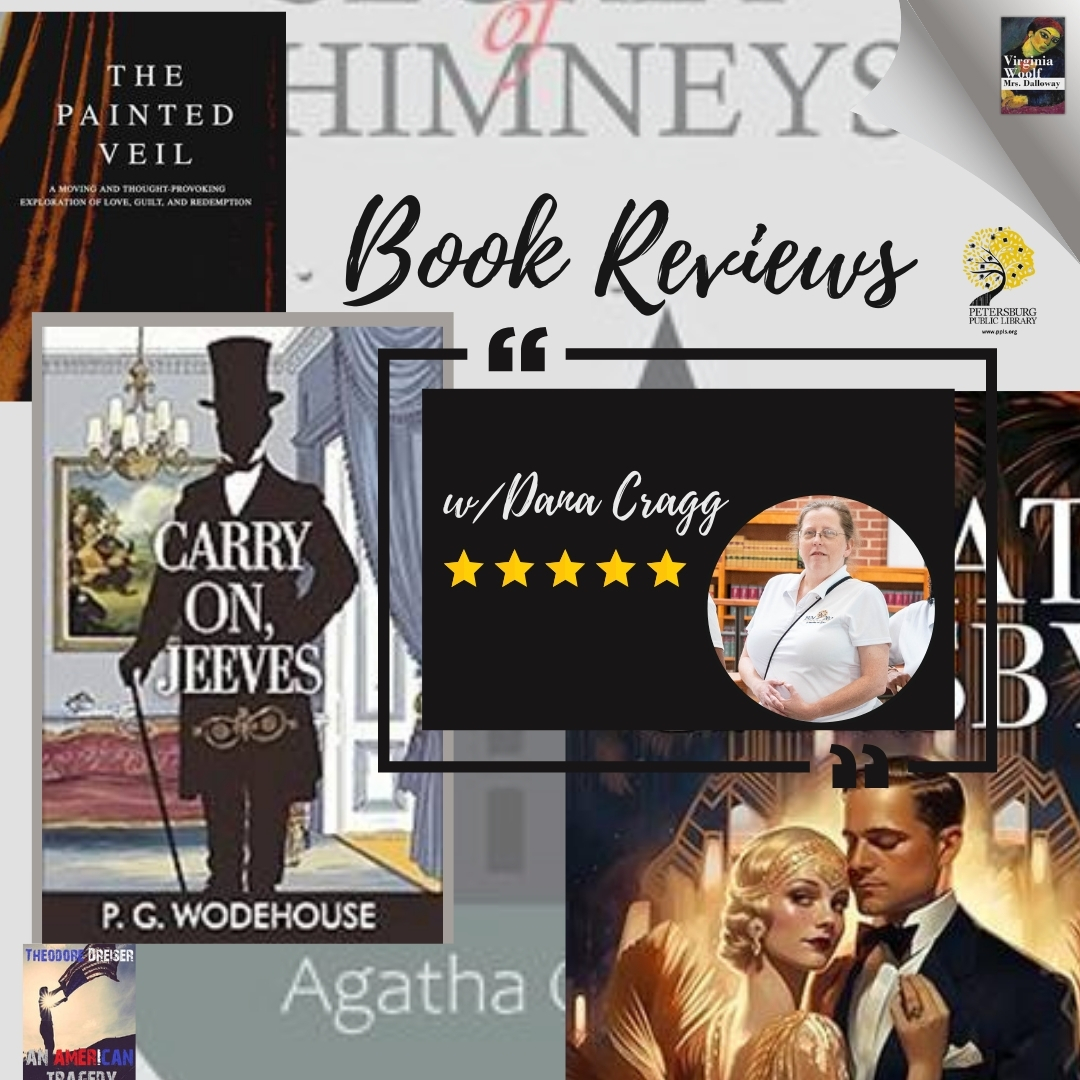
As you may know, the Petersburg Public Library recently celebrated its 100th anniversary. The library first opened its doors in August of 1924, meaning its inaugural full year of service was 1925. To honor this milestone, I thought it fitting to review a book published during that year.
A look at the notable literary works of 1925 revealed an impressive collection of enduring classics. Many titles from that year remain in print and widely read. After reviewing the list, I selected several novels available through the library and resolved to read and review one. My choices included An American Tragedy by Theodore Dreiser, The Secret of Chimneys by Agatha Christie, Carry On, Jeeves by P.G. Wodehouse, The Painted Veil by W. Somerset Maugham, and Mrs. Dalloway by Virginia Woolf. This was also the year of The Great Gatsby by F. Scott Fitzgerald, which I had read before and eagerly revisited for this project.
One observation about these selections stands out: only two authors, Dreiser and Fitzgerald, are American, while the others are English. This geographical split offered a fascinating lens through which to explore themes of class, ambition, and identity on both sides of the Atlantic. Rather than reviewing each novel individually, I decided to examine them collectively, highlighting shared themes and their significance in the literary landscape of 1925.
Common Threads Across the Atlantic
As I began reading, I noticed intriguing parallels between these works, despite their diverse settings and tones. A peculiar connection emerged early on: in An American Tragedy, characters reference Schenectady, New York, as a destination for revelry, a detail echoed in Carry On, Jeeves, where P.G. Wodehouse’s Bertie Wooster also mentions Schenectady. This coincidence prompted me to imagine Wodehouse’s lighthearted characters mingling with the grimly drawn figures of Dreiser’s world.
Surprisingly, such a crossover didn’t feel entirely implausible. The wealthy, beautiful young people populating Dreiser’s and Fitzgerald’s novels could easily inhabit Wodehouse’s high-society settings, sharing common themes of class-consciousness, social mobility, and the pursuit of happiness—or its illusion. Across both American and British literature of the time, these themes were prominent, underscoring the universal struggles and aspirations of the era.
An American Tragedy by Theodore Dreiser
Dreiser’s An American Tragedy is a sprawling, ambitious novel divided into three parts. The first section draws readers in with its brisk pacing and vivid portrayal of Clyde Griffiths’ life. However, the second part slows considerably, bogged down by repetitive introspection as Clyde wrestles with his conflicting desires and moral failings. The final section redeems the story, introducing new characters and exploring the legal and emotional aftermath of Clyde’s decisions.
Clyde himself is a thoroughly flawed protagonist. Selfish, morally weak, and consumed by ambition, he is both compelling and repellent. Dreiser’s exploration of his psyche reflects Freudian influences, particularly in Clyde’s strained relationship with his mother and fixation on wealth and status. Despite the novel’s length and occasional tedium, its powerful narrative and psychological depth make it a worthwhile read—if one doesn’t mind skimming repetitive passages.
The Great Gatsby by F. Scott Fitzgerald
Rereading The Great Gatsby as an adult revealed layers I had missed in high school. Like Clyde Griffiths, Jay Gatsby is driven by a desire to transcend his humble beginnings. Yet Gatsby’s charm and relentless optimism elevate him to the status of a tragic hero, in stark contrast to Clyde’s haplessness.
Fitzgerald’s luminous prose and concise storytelling stand in stark contrast to Dreiser’s dense, sprawling narrative. Both novels, however, offer incisive critiques of the Jazz Age, exposing the emptiness behind its glittering facade. Together, they provide a nuanced portrait of 1920s America, capturing its allure and disillusionment.
Carry On, Jeeves by P.G. Wodehouse
In contrast to the grim realities explored by Dreiser and Fitzgerald, Wodehouse offers delightful escapism. His collection of short stories follows Bertie Wooster and his ingenious valet Jeeves as they navigate the absurdities of upper-class society. The humor is timeless, and Wodehouse’s affection for his characters shines through in every line.
Despite its comedic tone, Carry On, Jeeves shares a thematic undercurrent with its American counterparts: the foibles of the wealthy and the pursuit of happiness, however misguided. Wodehouse’s genius lies in his ability to satirize these themes while maintaining a sense of warmth and charm.
The Secret of Chimneys by Agatha Christie
Agatha Christie’s The Secret of Chimneys is an early entry in her illustrious career, introducing Superintendent Battle in a tale of murder, international intrigue, and hidden identities. While not as polished as her later works, this novel is a quick, entertaining read that showcases Christie’s knack for crafting engaging puzzles.
The smaller cast and brisk pacing make this a perfect choice for a rainy afternoon. It’s a reminder of Christie’s enduring appeal, even in her formative years.
The Painted Veil by W. Somerset Maugham
Maugham’s novella The Painted Veil follows Kitty, a young woman whose impulsive marriage and subsequent betrayal lead her to self-discovery in an unfamiliar setting. Set in China, the story explores themes of redemption and personal growth with a keen psychological insight.
Kitty’s transformation is both believable and inspiring, culminating in a resolution that affirms her independence and resilience. Of all the books I read for this project, The Painted Veil stood out as my favorite for its elegant prose and profound emotional depth.
Mrs. Dalloway by Virginia Woolf
Virginia Woolf’s Mrs. Dalloway is a masterpiece of stream-of-consciousness writing, focusing on a single day in the life of its titular character. The narrative weaves past and present seamlessly, offering a meditative exploration of time, memory, and identity.
While I appreciated Woolf’s artistry, I found Mrs. Dalloway less engaging than the other novels—a matter of personal taste rather than literary merit. For those who enjoy introspective, character-driven stories, this novel remains a landmark achievement.
Final Thoughts
The books of 1925 offer a rich tapestry of perspectives, reflecting a world grappling with rapid change, social upheaval, and enduring class divisions. From Dreiser’s incisive realism to Wodehouse’s comedic brilliance, each work provides a unique window into its time. Whether you seek thought-provoking drama, thrilling intrigue, or lighthearted escapism, the literature of this year has something to offer.
As we celebrate a century of the Petersburg Public Library, it’s remarkable to reflect on the enduring power of stories to connect and inspire us across generations. These novels, published a century ago, continue to resonate, proving that great literature transcends time.

